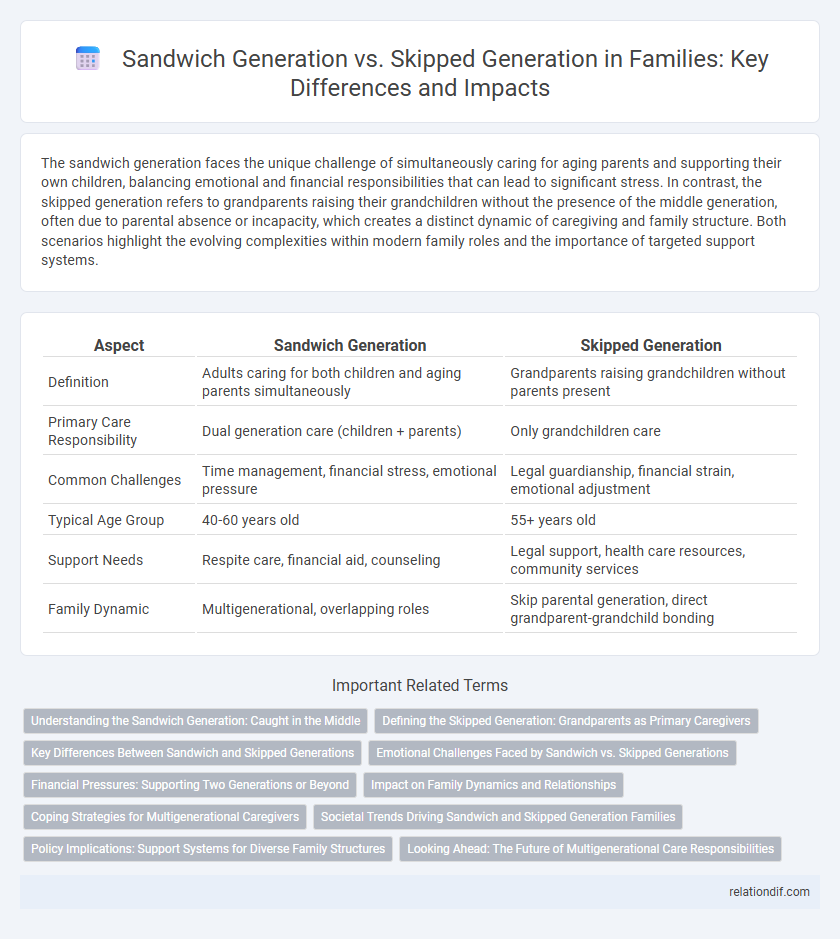The sandwich generation faces the unique challenge of simultaneously caring for aging parents and supporting their own children, balancing emotional and financial responsibilities that can lead to significant stress. In contrast, the skipped generation refers to grandparents raising their grandchildren without the presence of the middle generation, often due to parental absence or incapacity, which creates a distinct dynamic of caregiving and family structure. Both scenarios highlight the evolving complexities within modern family roles and the importance of targeted support systems.
Table of Comparison
| Aspect | Sandwich Generation | Skipped Generation |
|---|---|---|
| Definition | Adults caring for both children and aging parents simultaneously | Grandparents raising grandchildren without parents present |
| Primary Care Responsibility | Dual generation care (children + parents) | Only grandchildren care |
| Common Challenges | Time management, financial stress, emotional pressure | Legal guardianship, financial strain, emotional adjustment |
| Typical Age Group | 40-60 years old | 55+ years old |
| Support Needs | Respite care, financial aid, counseling | Legal support, health care resources, community services |
| Family Dynamic | Multigenerational, overlapping roles | Skip parental generation, direct grandparent-grandchild bonding |
Understanding the Sandwich Generation: Caught in the Middle
The sandwich generation refers to adults simultaneously caring for their aging parents while supporting their own children, creating significant emotional and financial strain. In contrast, the skipped generation involves grandparents raising grandchildren without the presence of the middle generation, often due to parental absence or incapacity. Understanding these differing family dynamics is crucial for developing targeted social support and policies that address multigenerational caregiving challenges.
Defining the Skipped Generation: Grandparents as Primary Caregivers
Skipped generation families consist of grandparents raising their grandchildren without the presence of the parents, often due to parental incapacity or absence. These grandparents assume full-time caregiving responsibilities, managing daily routines, education, and emotional support for their grandchildren. This caregiving dynamic differs significantly from the sandwich generation, where middle-aged adults balance caring for both their aging parents and their children simultaneously.
Key Differences Between Sandwich and Skipped Generations
The sandwich generation simultaneously cares for aging parents and their own children, creating a dual caregiving role that impacts financial and emotional resources. In contrast, the skipped generation involves grandparents raising grandchildren without the presence of the middle generation, often due to parental absence from issues like incarceration or substance abuse. Key differences include the caregiving structure, with the sandwich generation balancing responsibilities between two generations, while skipped generation families focus exclusively on child-rearing and grandparent roles.
Emotional Challenges Faced by Sandwich vs. Skipped Generations
Sandwich generation caregivers often experience heightened emotional stress from balancing care for aging parents and their own children, leading to feelings of guilt and burnout. In contrast, skipped generation caregivers, typically grandparents raising grandchildren, face isolation and role confusion while managing responsibility without parental involvement. Both groups contend with unique emotional challenges rooted in caregiving demands and intergenerational dynamics.
Financial Pressures: Supporting Two Generations or Beyond
The sandwich generation faces significant financial pressures as they support both aging parents and their own children, often managing healthcare costs, education expenses, and daily living needs simultaneously. Skipped generation households, where grandparents primarily provide for grandchildren, confront unique financial challenges including limited retirement savings and increased childcare responsibilities. Both family structures require strategic financial planning to balance multigenerational support without compromising long-term economic stability.
Impact on Family Dynamics and Relationships
The sandwich generation faces significant stress balancing caregiving responsibilities for both aging parents and their own children, which often leads to strained relationships and limited personal time. In contrast, skipped generation families, where grandparents are primary caregivers, experience shifts in family roles that can strengthen intergenerational bonds but also create challenges in authority and communication. Both dynamics require adaptive coping strategies to maintain family cohesion and emotional well-being.
Coping Strategies for Multigenerational Caregivers
Multigenerational caregivers in the sandwich generation balance responsibilities for aging parents and dependent children by implementing time management techniques and seeking support networks to reduce stress. Skipped generation caregivers, often grandparents raising grandchildren without middle-generation parents, utilize community resources and respite care to sustain emotional and physical health. Both groups benefit from establishing clear boundaries and accessing professional counseling to enhance coping efficacy.
Societal Trends Driving Sandwich and Skipped Generation Families
Rising life expectancy and increased economic pressures contribute to the growth of sandwich generation families, where adults simultaneously care for aging parents and young children. Skipped generation households, often led by grandparents raising grandchildren, emerge due to factors like parental incarceration, substance abuse, and financial instability. Societal shifts such as delayed marriage, workforce participation changes, and healthcare advancements significantly influence these family dynamics.
Policy Implications: Support Systems for Diverse Family Structures
Policy implications for the sandwich generation, which simultaneously cares for aging parents and children, emphasize the need for flexible workplace protections and affordable eldercare services to alleviate caregiving burdens. In contrast, skipped generation families, where grandparents primarily raise grandchildren, require targeted social support such as legal guardianship assistance and supplemental income programs to address unique financial and caregiving challenges. Developing inclusive policies that recognize these diverse family structures promotes stability and well-being across multigenerational households.
Looking Ahead: The Future of Multigenerational Care Responsibilities
Multigenerational care responsibilities will increasingly challenge the sandwich generation, who simultaneously support aging parents and growing children, as demographic shifts lead to longer life expectancies and evolving family structures. Skipped generation families, where grandparents become primary caregivers for grandchildren, will also see rising prevalence, driven by factors like parental incarceration or economic hardship. Adapting social policies and healthcare resources to address these dual caregiving demands is crucial for sustainable family support systems.
sandwich generation vs skipped generation Infographic

 relationdif.com
relationdif.com